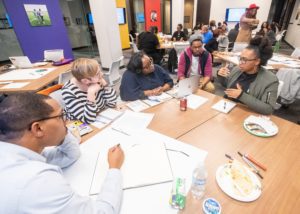
Blog
How Design Thinking is Helping Transform Ideas Into Reality
What would the world be without big ideas?
They play a crucial role in creating change and developing solutions to our communities’ largest problems. But equally important to a big idea is a clear plan to transform it into reality.
Making this transition is a key component of the My Brother’s Keeper Detroit Innovation Challenge as a collection of semi-finalist teams prepare to launch their big ideas to expand opportunity for Detroit’s young people of color.
In most cases, the designing, testing, and implementation of ideas this size would take months, if not years, to accomplish. But with only a handful of weeks to launch, the semi-finalists need an innovative and effective way to prototype, test, and measure their impact. So how can it be done?
Enter design thinking, a human-centered process that helps develop effective and creative solutions to large and complex challenges. As a central component of the Challenge’s prototyping process, design thinking plays a crucial role in helping the teams think about their ideas and develop actionable plans to implement them given the resources and time available.
While design thinking can help solve complex issues, the process itself is rather simple and can be broken down into five main steps:
 Empathize
Empathize
Before a solution can be found, teams developed a plan to gain an empathic understanding of the people they intend to impact in order to see the experiences and challenges they face. This represented an important step for Challenge teams as it ensured youth were active participants in shaping the impact each organization would have.
 Define
Define
Once background information is gathered, it is compiled and organized to create a clear definition of the problem to be solved.
 Ideate
Ideate
With a clearly defined problem, the next step consists of generating new ideas and solutions, regardless of how big, small, or wild they may be.
 Prototype
Prototype
Selecting the best idea from the list developed, the teams ask themselves: “What is the smallest and most inexpensive version of this idea that we can launch, test, and measure in a few weeks?” Once this prototype is developed, teams engage with youth to evaluate the impact their idea would have.
 Test
Test
Finally, teams review the results of their prototype, gain feedback from the youth engaged, and measure the intended impact the idea created.
Though there are defined steps, design thinking is by no means a linear process and often requires users to go back, edit, and retest their ideas based on feedback and developments during the cycle. In a sense, it’s more of a framework for problem solving rather than a search for a singular “right” or “wrong” answer.
“Everything we thought was challenged to become better, more attainable, and more impactful,” said Desirae Tolbert, organizer of Reading Behind Bars. “As a result, we have incorporated several components into pilots and planning strategies.”
While the accelerated process of the Challenge may seem like a daunting task, design thinking requires users to be intuitive, open minded and creative, which helps transform teams’ big ideas into testable prototypes over a few weeks.
“The design thinking process taught me how to take my big ideas, scale them down, move beyond ideation into a pilot that yields potentially sustainable outcomes,” said Courtney Smith, organizer of Detroit Phoenix Center’s team.
With a clear plan in place and prototypes ready to test, the MBK Detroit Innovation Challenge semifinalists are looking to make an impact for the city’s youth of color. Stay tuned for more details and see their results on February 12 at the MBK Detroit Innovation Challenge Community Expo!
Watch the 21 semi-finalists teams share the ideas to create opportunity for Detroit youth at the MBK Detroit Innovation Challenge Community Expo on February 12! Six finalists will receive $50,000 to grow their organization. Audience members will select a favorite team to win a $5,000 Audience Choice Award.


Awesome article William!
Thanks for this great overview of design thinking as a way to tackle big and complex issues. Particularly appreciate the first grounding stage of empathetic understanding!